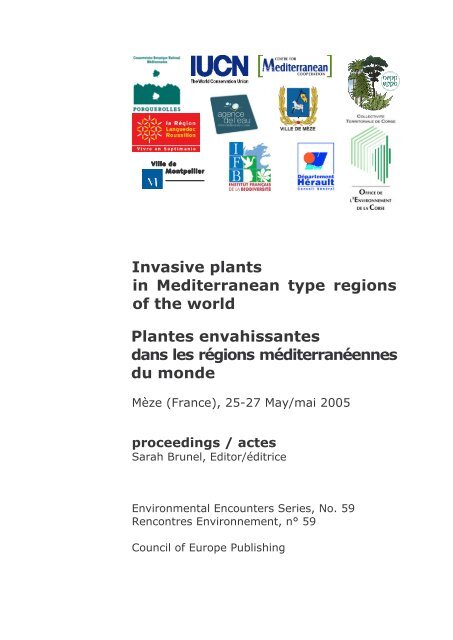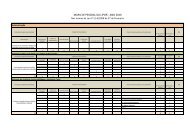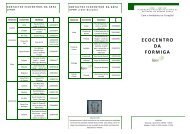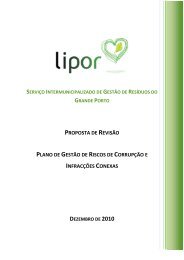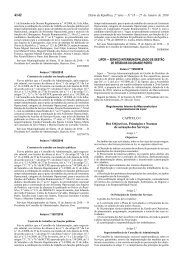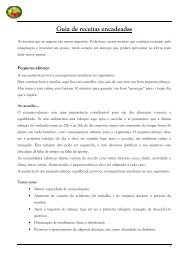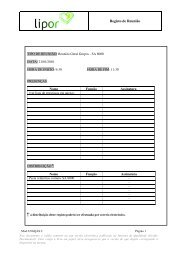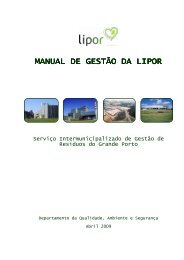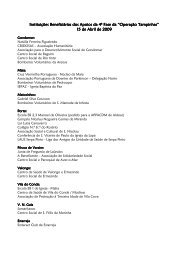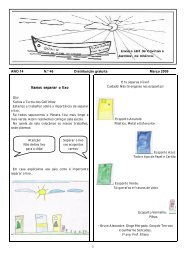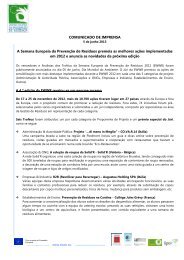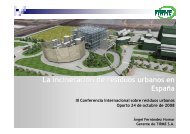Invasive plants in Mediterranean type regions of the world ... - Lipor
Invasive plants in Mediterranean type regions of the world ... - Lipor
Invasive plants in Mediterranean type regions of the world ... - Lipor
You also want an ePaper? Increase the reach of your titles
YUMPU automatically turns print PDFs into web optimized ePapers that Google loves.
<strong>Invasive</strong> plant species <strong>in</strong> Portugal: an overview<br />
Hélia Marchante1, Elizabete Marchante2, Helena Freitas2<br />
1 Sector de Biologia e Ecologia, Escola Superior Agrária de Coimbra, 3040-316 Coimbra,<br />
Portugal<br />
2 Departamento de Botânica, Universidade de Coimbra, 3049 Coimbra, Portugal<br />
Email: hmarchante@esac.pt<br />
Abstract<br />
The <strong>in</strong>vasion by exotic <strong>plants</strong> is threaten<strong>in</strong>g <strong>the</strong> Portuguese native flora becom<strong>in</strong>g a<br />
serious environmental problem. In <strong>the</strong> last two centuries, and especially <strong>in</strong> recent<br />
decades, <strong>the</strong> number <strong>of</strong> <strong>in</strong>troduced plant species <strong>in</strong>creased extensively with aliens<br />
represent<strong>in</strong>g nowadays more than 15 % <strong>of</strong> a total <strong>of</strong> ca. 3200 taxa <strong>of</strong> <strong>the</strong> Portuguese<br />
vascular flora. Their presence has <strong>in</strong>creased probably more than 1000 % dur<strong>in</strong>g <strong>the</strong><br />
last two centuries, reach<strong>in</strong>g nowadays <strong>the</strong> worry<strong>in</strong>g figure <strong>of</strong> about 500 species.<br />
Almost 40 % <strong>of</strong> <strong>the</strong> listed species are actually or potentially <strong>in</strong>vasive, <strong>in</strong>clud<strong>in</strong>g<br />
agricultural weeds and <strong>in</strong>vaders <strong>of</strong> natural habitats, and ca. 7% are considered<br />
dangerous <strong>in</strong>vaders. Legum<strong>in</strong>osae and Asteraceae provide <strong>the</strong> largest numbers <strong>of</strong><br />
problematic species. Australia seems to supply <strong>the</strong> most dangerous and aggressive<br />
<strong>in</strong>vaders <strong>in</strong> Portugal, <strong>in</strong>clud<strong>in</strong>g several Acacia and Hakea species. From different<br />
orig<strong>in</strong>s and taxonomies Ailanthus altissima and Cortaderia selloana also worth special<br />
attention due to <strong>the</strong> current drastic <strong>in</strong>crease <strong>in</strong> <strong>the</strong>ir distribution.<br />
Recently, Portuguese legislation has recognised this problem (dec.- lei 565/99),<br />
creat<strong>in</strong>g a list <strong>of</strong> <strong>the</strong> exotic species <strong>in</strong>troduced, identify<strong>in</strong>g <strong>the</strong> <strong>in</strong>vasive ones, and<br />
forbidd<strong>in</strong>g <strong>the</strong> <strong>in</strong>troduction <strong>of</strong> new species unless proven not harmful. Although this<br />
list does not <strong>in</strong>clude all <strong>the</strong> species <strong>in</strong>troduced and despite <strong>the</strong> fact that <strong>the</strong>re are<br />
exceptions for forestry and agricultural purposes, it is a good start<strong>in</strong>g po<strong>in</strong>t. The<br />
legislative process is still be<strong>in</strong>g implemented and will apply penalties to <strong>the</strong> use <strong>of</strong><br />
listed <strong>in</strong>vasive species. As next steps, <strong>the</strong> list needs updat<strong>in</strong>g and it is essential to<br />
implement <strong>the</strong> regulations <strong>in</strong> <strong>the</strong> field with <strong>in</strong>spections to horticulturist, landscape<br />
architectures, gardeners, boarders and o<strong>the</strong>rs. Technician‘s tra<strong>in</strong><strong>in</strong>g is still needed to<br />
assure <strong>the</strong> correct application <strong>of</strong> <strong>the</strong> legislation.<br />
Introduction<br />
The <strong>in</strong>vasion by exotic <strong>plants</strong> is threaten<strong>in</strong>g <strong>the</strong> Portuguese native flora and becom<strong>in</strong>g a<br />
serious environmental problem (Almeida & Freitas 2001, Campelo 2001, Marchante 2001;<br />
Almeida & Freitas, <strong>in</strong> press). In <strong>the</strong> last two centuries, and especially <strong>in</strong> recent decades, <strong>the</strong><br />
number <strong>of</strong> <strong>in</strong>troduced plant species <strong>in</strong>creased extensively with aliens represent<strong>in</strong>g nowadays<br />
more than 15 % <strong>of</strong> a total <strong>of</strong> ca. 3200 taxa <strong>of</strong> <strong>the</strong> Portuguese vascular flora (Almeida 1999).<br />
Their presence has <strong>in</strong>creased probably more than 1000 % dur<strong>in</strong>g <strong>the</strong> last two centuries, from<br />
33 known sub-spontaneous species <strong>in</strong> 1800 reach<strong>in</strong>g <strong>in</strong> 2005 <strong>the</strong> worry<strong>in</strong>g figure <strong>of</strong> about<br />
550 species (Almeida & Freitas, <strong>in</strong> press) and still <strong>in</strong>creas<strong>in</strong>g (Figure 1). This data should be<br />
seen as conservative with new <strong>in</strong>troductions <strong>in</strong> ornamental sector be<strong>in</strong>g frequent and <strong>of</strong>ten<br />
difficult to track. Almost 40 % <strong>of</strong> <strong>the</strong> listed species are actually or potentially <strong>in</strong>vasive,<br />
<strong>in</strong>clud<strong>in</strong>g agricultural weeds and <strong>in</strong>vaders <strong>of</strong> natural habitats, and ca. 7% are considered<br />
dangerous <strong>in</strong>vaders. Fabaceae and Asteraceae provide <strong>the</strong> largest numbers <strong>of</strong> problematic<br />
species. Australia seems to supply <strong>the</strong> most dangerous and aggressive <strong>in</strong>vaders <strong>in</strong> Portugal,<br />
<strong>in</strong>clud<strong>in</strong>g several Acacia and Hakea species.<br />
99
no <strong>of</strong> species<br />
Figure1. Increase <strong>of</strong> exotic plant<br />
species <strong>in</strong>troduced <strong>in</strong> Portugal s<strong>in</strong>ce<br />
1500 (based on Almeida 1999;<br />
Almeida & Freitas, <strong>in</strong> press).<br />
Some <strong>of</strong> <strong>the</strong> worst examples <strong>of</strong><br />
species responsible for threaten<strong>in</strong>g<br />
<strong>the</strong> Portuguese native flora (Table<br />
I) are given by species <strong>of</strong> <strong>the</strong><br />
genus Acacia (Marchante et al. 2003), Hakea and Carpobrotus (P<strong>in</strong>to da Silva et al. 1989,<br />
Campelo 2001); Ailanthus altissima and Cortaderia selloana also worth special attention<br />
due to <strong>the</strong> current drastic <strong>in</strong>crease <strong>in</strong> <strong>the</strong>ir distribution. The big spread <strong>of</strong> some <strong>of</strong> <strong>the</strong>se<br />
species, namely <strong>the</strong> ones with tree habit, has already displaced large areas <strong>of</strong> native<br />
vegetation, <strong>in</strong>clud<strong>in</strong>g several areas with conservation <strong>in</strong>terest which preservation is<br />
nowadays seriously threatened.<br />
Table I. Some <strong>of</strong> <strong>the</strong> worst and more aggressive <strong>in</strong>vasive plant species present <strong>in</strong> Portugal<br />
Family Species Introd.purpose Habitats <strong>in</strong>vaded<br />
Aizoaceae<br />
evolution <strong>of</strong> exotic plant species <strong>in</strong> Portugal<br />
600<br />
500<br />
400<br />
300<br />
200<br />
100<br />
0<br />
1500 1600 1700 1800 1850 1900 1950 2005<br />
Carpobrotus edulis (L.) N.E.<br />
Br.<br />
(South Africa)<br />
Apiaceae Eryngium pandanifolium<br />
(Umbelliferae) Cham. & Schlecht……………<br />
……………..(South America)<br />
Commel<strong>in</strong>aceae Tradescantia flum<strong>in</strong>ensis<br />
Velloso (South America)<br />
Convolvulaceae Ipomoea acum<strong>in</strong>ata (Vahl)<br />
Roem.&Sch.(Tropical <strong>regions</strong>)<br />
Haloragaceae Myriophyllum aquaticum<br />
(Vel.) Verdc. (South America)<br />
Fabaceae Acacia dealbata L<strong>in</strong>k……<br />
(SE Australia and Tasmania)<br />
(Legum<strong>in</strong>osae) Acacia melanoxylon R. Br.<br />
(SE Australia and Tasmania)<br />
Pittosporaceae<br />
Poaceae<br />
(Gram<strong>in</strong>eae)<br />
Pontederiaceae<br />
Proteaceae<br />
Simaroubaceae<br />
Acacia longifolia (Andrews)<br />
Willd. (Australia)<br />
Rob<strong>in</strong>ia pseudoacacia L.<br />
(eastern North America)<br />
Pittosporum undulatum Vent.<br />
(Australia)<br />
Cortaderia selloana (Schultes<br />
& Schultes fil.) Ascherson &<br />
Graebner (South America)<br />
Eichhornia crassipes (C.F.P.<br />
Mart.) Solms-Laub. (Tropical<br />
South America)<br />
Hakea sericea Schrad.<br />
(Eastern Australia)<br />
Hakea salicifolia (Vent.) B.L.<br />
Burtt<br />
(SE Australia and Tasmania)<br />
Ailanthus altissima (Miller)<br />
Sw<strong>in</strong>gle (Ch<strong>in</strong>a)<br />
ornamental and<br />
to fix sand dunes<br />
and slopes<br />
ornamental<br />
ornamental<br />
Ornamental<br />
accidental<br />
<strong>in</strong>troduction<br />
slopes stability<br />
and ornamental<br />
ornamental;<br />
forestry, shadow<br />
curb sand erosion;<br />
ornamental<br />
forestry,<br />
ornamental and<br />
soil stabilization<br />
ornamental and<br />
shelter<br />
Ornamental<br />
Ornamental<br />
ornamental and<br />
quickset hedges<br />
ornamental;<br />
w<strong>in</strong>d break<br />
especially near<br />
<strong>the</strong> coast<br />
Ornamental<br />
coastal sand dunes, capes<br />
and next to slopes where it<br />
was planted<br />
near waterl<strong>in</strong>es <strong>in</strong> <strong>the</strong> low<br />
Mondego Bas<strong>in</strong><br />
shadow and humid areas;<br />
managed woods understory<br />
large carpets <strong>in</strong> disturbed<br />
habitats and slopes<br />
aquatic habitats<br />
mounta<strong>in</strong> areas, roads and<br />
river marg<strong>in</strong>s;<br />
along roads, and mounta<strong>in</strong><br />
areas adjacent to where it<br />
was planted<br />
coastal areas (sand dunes<br />
and capes); along rivers; …<br />
near rivers and roads;<br />
p<strong>in</strong>ewoods and disturbed<br />
lands<br />
managed areas where it was<br />
planted as ornamental<br />
spread<strong>in</strong>g <strong>in</strong> some dune<br />
systems and along roads/<br />
highways/ rails or o<strong>the</strong>r<br />
water-courses and lagoons<br />
p<strong>in</strong>ewoods and disturbed<br />
lands; isolated <strong>in</strong>dividuals <strong>in</strong><br />
relatively prist<strong>in</strong>e places<br />
coastal areas (sand dunes),<br />
mounta<strong>in</strong> areas where it was<br />
planted and disturbed lands<br />
spread ma<strong>in</strong>ly <strong>in</strong> urban areas<br />
and <strong>in</strong> road sides<br />
100
Portuguese legislation<br />
Early <strong>in</strong> 1974, a first law (decreto-lei 165/74 de 22 Abril) recognized water-hyac<strong>in</strong>th<br />
(Eichhornia crassipes) as an <strong>in</strong>vasive species, forbidd<strong>in</strong>g its importation, culture, sell<strong>in</strong>g,<br />
transport or possession. In 1999, <strong>the</strong> Portuguese law has recognized <strong>in</strong> a more wide-range <strong>the</strong><br />
problem <strong>of</strong> <strong>in</strong>vasive species (decreto-lei 565/99 de 21 de Dezembro), creat<strong>in</strong>g a list <strong>of</strong> <strong>the</strong><br />
exotic species <strong>in</strong>troduced, identify<strong>in</strong>g <strong>the</strong> <strong>in</strong>vasive ones, and forbidd<strong>in</strong>g <strong>the</strong> <strong>in</strong>troduction <strong>of</strong><br />
new species unless proven not harmful. This regulation was <strong>the</strong> result <strong>of</strong> <strong>the</strong> <strong>in</strong>ternational<br />
commitment assumed when Portugal approved, for ratification, <strong>the</strong> Bern Convention<br />
(decreto-lei n.º 95/81, de 23 de Julho), <strong>the</strong> Bone Convention (decreto-lei n.º 103/80, de 11 de<br />
Outubro) and <strong>the</strong> Convention <strong>of</strong> Biodiversity (decreto-lei n.º 21/93, de 21 de Junho), all<br />
suggest<strong>in</strong>g <strong>the</strong> adoption <strong>of</strong> measures limit<strong>in</strong>g <strong>the</strong> deliberate <strong>in</strong>troduction and prevent<strong>in</strong>g <strong>the</strong><br />
accidental <strong>in</strong>troduction <strong>of</strong> <strong>in</strong>vasive species, as well as <strong>the</strong> control or eradication <strong>of</strong> <strong>the</strong><br />
<strong>in</strong>vasive species already <strong>in</strong>troduced. A previous law from 1987 (Lei de Bases do Ambiente:<br />
decreto-lei n.º 11/87, de 7 de Abril) on article 15, no. 6, demanded <strong>the</strong> elaboration <strong>of</strong><br />
adequate legislation to regulate <strong>the</strong> <strong>in</strong>troduction <strong>of</strong> exotic plant species, and on article 16, no.<br />
3 <strong>the</strong> adoption <strong>of</strong> measures <strong>of</strong> effective control <strong>of</strong> <strong>the</strong> <strong>in</strong>troduction <strong>of</strong> any wild animal species<br />
both aquatic and terrestrial. The recent legislation was drawn to operate as a clean list<br />
approach, mean<strong>in</strong>g that every exotic species currently <strong>in</strong> <strong>the</strong> country should be listed <strong>in</strong> <strong>the</strong><br />
law and to <strong>in</strong>troduce any o<strong>the</strong>r species an authorization should be asked.<br />
The legislation was prepared by ICN (Institute <strong>of</strong> Nature Conservation, M<strong>in</strong>istry <strong>of</strong><br />
Environment) and DGF (Forestry National Services), with <strong>the</strong> collaboration <strong>of</strong> <strong>the</strong> scientific<br />
community, namely to set up <strong>the</strong> species list.<br />
The list <strong>of</strong> <strong>in</strong>vasive <strong>plants</strong><br />
The law <strong>in</strong>cludes 3 separated lists <strong>of</strong> species each presented as an annex: annex I, lists <strong>the</strong><br />
non <strong>in</strong>digenous plant and animal species <strong>in</strong>troduced <strong>in</strong> Portugal, and identifies those<br />
considered <strong>in</strong>vasive; <strong>the</strong> non <strong>in</strong>vasive species are called <strong>in</strong>digenous <strong>in</strong> what concerns <strong>the</strong><br />
application <strong>of</strong> this law! annex II, lists non <strong>in</strong>digenous species that are considered <strong>of</strong> <strong>in</strong>terest<br />
for garden<strong>in</strong>g and forestry; <strong>the</strong>se species are also considered <strong>in</strong>digenous <strong>in</strong> terms <strong>of</strong> <strong>the</strong><br />
application <strong>of</strong> this law! annex III, list <strong>the</strong> non <strong>in</strong>digenous species that already have<br />
ecological risk elsewhere but are not yet <strong>in</strong>vasive <strong>in</strong> Portugal.<br />
Call<strong>in</strong>g “<strong>in</strong>digenous” to all <strong>the</strong> species that are not listed as <strong>in</strong>vasive or do not hold<br />
ecological risk could lead to some mis<strong>in</strong>terpretation; particularly <strong>in</strong> <strong>the</strong> frequents occasions<br />
along <strong>the</strong> text when <strong>the</strong> non <strong>in</strong>digenous species are referred, not becom<strong>in</strong>g obvious which<br />
species are <strong>in</strong> fact <strong>in</strong>cluded or not.<br />
The content <strong>of</strong> <strong>the</strong> law<br />
The law limits <strong>the</strong> <strong>in</strong>tentional <strong>in</strong>troduction <strong>of</strong> exotic species <strong>in</strong> nature even if <strong>the</strong> aim is not to<br />
release it. Never<strong>the</strong>less, due to economical reasons, exceptions are considered to species<br />
used <strong>in</strong> agriculture (agriculture, horticulture and zootechnic). In practice, and particularly<br />
consider<strong>in</strong>g both <strong>in</strong>vasive (annex I. po<strong>in</strong>ted as <strong>in</strong>vasive) and species with ecological risk<br />
(annex III), it specifically prohibits: 1) its cultivation, growth, ma<strong>in</strong>tenance <strong>in</strong> conf<strong>in</strong>ed<br />
place, utilization as ornamental plant or pet; and 2) to give, to buy, to sell, and to transport<br />
specimens <strong>of</strong> those species except when <strong>the</strong>y are dead and do not hold any viable propagule.<br />
Exceptions are considered to scientific and educational purposes, as long as legally<br />
authorized by ICN.<br />
O<strong>the</strong>r exceptions are considered when propos<strong>in</strong>g <strong>the</strong> <strong>in</strong>troduction <strong>of</strong> a new species: 1) when<br />
it is proved to have unequivocal advantages to men <strong>of</strong> natural biocenosis; 2) when <strong>the</strong>re is no<br />
native species that fit to <strong>the</strong> same purpose; 3) when <strong>the</strong> <strong>in</strong>troduction is preceded by a<br />
rigorous study <strong>of</strong> impacts whose results will be relevant to <strong>the</strong> authorization. This study,<br />
101
additionally to biological and ecological characterization, can <strong>in</strong>clude controlled experiments<br />
under conf<strong>in</strong>ement which should be controlled by an adm<strong>in</strong>istrative entity. The authorization<br />
or rejection <strong>of</strong> <strong>in</strong>troduction depends on <strong>the</strong> f<strong>in</strong>al evaluation <strong>of</strong> this entity.<br />
Exceptions are not to be allowed if <strong>the</strong> area where <strong>the</strong> species is meant to be <strong>in</strong>troduced<br />
<strong>in</strong>cludes a protected area, a zone <strong>of</strong> special protection, a Natura 2000 site, an island without<br />
human population or natural lagoons. In <strong>the</strong>se particular cases, it will only be allowed if <strong>the</strong><br />
species is <strong>the</strong> only viable option to nature conservation or if human health or safety depends<br />
on it.<br />
Field impacts <strong>of</strong> <strong>the</strong> application <strong>of</strong> <strong>the</strong> law<br />
Entities such as botanical gardens, nurseries, greenhouses, plant shops, pet shops, zoological<br />
parks, circus, game parks, etc. need to request a license to ICN to deta<strong>in</strong> non <strong>in</strong>digenous<br />
species specify<strong>in</strong>g <strong>the</strong> list <strong>of</strong> <strong>the</strong> species already deta<strong>in</strong>ed. O<strong>the</strong>r legislation (ex. CITES)<br />
should also be respected. If <strong>the</strong> license is conceded, regular visits from environmental bureau<br />
(<strong>in</strong>clud<strong>in</strong>g ICN) or o<strong>the</strong>r people with specific competences (governmental <strong>in</strong>stitutions<br />
particularly responsible by agriculture, forestry, veter<strong>in</strong>ary, fish<strong>in</strong>g and aquaculture, and<br />
police force entities), should be forecasted to check <strong>the</strong> safety conditions <strong>of</strong> <strong>the</strong> places that<br />
deta<strong>in</strong> <strong>the</strong> species, and to check updat<strong>in</strong>g <strong>of</strong> <strong>the</strong> species list.<br />
Places that commercialize exotic plant and/or animals should expose to <strong>the</strong> public a synopsis<br />
<strong>of</strong> this law (published as annex 4).<br />
When a new species (<strong>the</strong>oretically all <strong>the</strong> species not <strong>in</strong>cluded <strong>in</strong> annex I, II or III) is to be<br />
<strong>in</strong>troduced an authorization should be requested to ICN. When <strong>the</strong> species to <strong>in</strong>troduce is<br />
dest<strong>in</strong>ed to be used as forestry or synergetic <strong>the</strong> authorization has to be asked to DGF,<br />
consult<strong>in</strong>g <strong>the</strong> ICN. To prevent accidental <strong>in</strong>troductions <strong>the</strong> species should be submitted to<br />
quarant<strong>in</strong>e follow<strong>in</strong>g rules imposed <strong>in</strong> ICN or DGF proposals.<br />
O<strong>the</strong>r technical-scientific and adm<strong>in</strong>istrative tasks contemplated <strong>in</strong> this legislation should be<br />
assured by ICN, sometimes with collaboration from DGF.<br />
Penalties are considered from 150€ to 45000€ to be paid for faults that could <strong>in</strong>clude <strong>the</strong><br />
detention <strong>of</strong> an <strong>in</strong>vasive species or <strong>the</strong> nonexistence <strong>of</strong> <strong>the</strong> license to deta<strong>in</strong> <strong>the</strong> non<br />
<strong>in</strong>digenous species, and it varies if be<strong>in</strong>g a private person or collective entity. The penalties<br />
could also <strong>in</strong>clude <strong>in</strong>terdiction <strong>of</strong> <strong>the</strong> permit to keep <strong>the</strong> pr<strong>of</strong>ession or activity; or clos<strong>in</strong>g a<br />
commercial establishment.<br />
How is <strong>the</strong> law seen by people that deal with exotic species<br />
It is not! In a recent prelim<strong>in</strong>ary query to horticulturists, pet shops and garden<strong>in</strong>g centers,<br />
simple questions were asked about <strong>the</strong>ir knowledge regard<strong>in</strong>g this legislation and its<br />
implications. Most <strong>of</strong> <strong>the</strong> answers revealed <strong>the</strong> lack <strong>of</strong> <strong>in</strong>formation about it!<br />
Theoretically, <strong>the</strong> places that deta<strong>in</strong> exotic species should have asked for a license and sent a<br />
list <strong>of</strong> <strong>the</strong> non <strong>in</strong>digenous species deta<strong>in</strong>ed to ICN from edition <strong>of</strong> <strong>the</strong> law to 6 months<br />
after… we believe it never happened…<br />
Next steps and suggestions<br />
Some species were miss<strong>in</strong>g <strong>in</strong> all 3 annex right from <strong>the</strong> beg<strong>in</strong>n<strong>in</strong>g, and now, 6 years after,<br />
<strong>the</strong> lists are far from be<strong>in</strong>g complete (figure 2) and need to be updated; new <strong>in</strong>troductions,<br />
ma<strong>in</strong>ly due to ornamental purpose, species shift<strong>in</strong>g category, namely species becom<strong>in</strong>g new<br />
<strong>in</strong>vaders, and some synonym <strong>in</strong>accuracy are already numerous and should be altered.<br />
It is essential to implement <strong>the</strong> regulations <strong>in</strong> <strong>the</strong> field with a strong effort on <strong>in</strong>form<strong>in</strong>g<br />
citizens directly <strong>in</strong>volved and implement<strong>in</strong>g <strong>in</strong>spections to horticulturist, pet shops, garden<br />
centers, boarders and o<strong>the</strong>rs. Technician‘s tra<strong>in</strong><strong>in</strong>g is still needed to assure <strong>the</strong> correct<br />
application <strong>of</strong> <strong>the</strong> legislation, namely <strong>in</strong> differentiat<strong>in</strong>g all <strong>the</strong> species listed.<br />
102
no.<strong>of</strong> species<br />
600<br />
400<br />
200<br />
exotic plant species <strong>in</strong> Portugal<br />
0<br />
410<br />
500<br />
potencially <strong>in</strong>vasive<br />
unkown potencial<br />
<strong>in</strong>vasive 550<br />
totals<br />
decreto 565/99 Almeida 1999 this work<br />
Figure 2. Exotic <strong>plants</strong> species<br />
categorized accord<strong>in</strong>g to its<br />
<strong>in</strong>vasiveness <strong>in</strong> Portugal,<br />
follow<strong>in</strong>g<br />
different<br />
bibliographic sources: <strong>the</strong><br />
legislation (dec.565/99),<br />
Almeida (1999), and a brief<br />
update prepared to this work.<br />
To facilitate <strong>the</strong> evaluation, when someone asks for authorization to <strong>in</strong>troduce a new species,<br />
this legislation could consider a quicker way to first assess its weedy potential. For <strong>in</strong>stance,<br />
a numerical score (like Australian legislation) <strong>in</strong>clud<strong>in</strong>g plant’s prior history <strong>of</strong> weed<strong>in</strong>ess,<br />
climate preferences, biological, reproductive and dispersal traits. Each new species to be<br />
<strong>in</strong>troduced would be scored by expertise’s and accord<strong>in</strong>g to <strong>the</strong> result it would have a “yes”<br />
or “no” quick answer, or could demand some tests.<br />
Acknowledgement<br />
To Mário Reis (ICN), for constructive discussions about <strong>the</strong> decreto-lei 565/99.<br />
References<br />
Almeida, J.D. 1999. Flora exótica subespontânea de Portugal cont<strong>in</strong>ental (plantas<br />
vasculares). 2.ª edição. Catálogo das plantas vasculares exóticas que ocorrem<br />
subespontâneas em Portugal cont<strong>in</strong>ental e compilação de <strong>in</strong>formações sobre estas plantas.<br />
Dissertação de Mestrado. Faculdade de Ciências e Tecnologia da Universidade de Coimbra.<br />
Almeida, J.D. & H. Freitas. 2001. The exotic and <strong>in</strong>vasive flora <strong>of</strong> Portugal. Bot.<br />
Complutensis 25: 317-327.<br />
Almeida, J.D. & H. Freitas. The exotic and <strong>in</strong>vasive flora <strong>of</strong> Portugal: a reassessment Bot.<br />
Complutensis (<strong>in</strong> press).<br />
Campelo, F. 2001. Estudo da exótica Carpobrotus edulis em ecossistemas dunares<br />
Portugueses. Dissertação de Mestrado. Faculdade de Ciências e Tecnologia da Universidade<br />
de Coimbra.<br />
Marchante, H. 2001. Invasão dos ecossistemas dunares portugueses por Acacia: uma ameaça<br />
para a biodiversidade nativa. 2001. Dissertação de Mestrado. Faculdade de Ciências e<br />
Tecnologia da Universidade de Coimbra.<br />
Marchante, H; Marchante, E & Freitas, H. 2003. Invasion <strong>of</strong> <strong>the</strong> Portuguese dune ecosystems<br />
by <strong>the</strong> exotic species Acacia longifolia (Andrews) Willd.: effects at <strong>the</strong> community level. In:<br />
Child, L.E.; Brock, J.H.; Brundu, G; Prach, K.; Pysek, P.; Wade, P.M. e Williamson, M.<br />
Plant Invasions: Ecological Threats and Management Solutions. Pp. 75-85. Backhuys<br />
Publishers. The Ne<strong>the</strong>rlands. Pp.75-85.<br />
M<strong>in</strong>istério do Ambiente. 1999. Decreto-lei n.º 565/99 de 21 de Dezembro. In: Diário da<br />
República - I Série – A. 295: 9100-9114.<br />
P<strong>in</strong>to da Silva, A.R., J.J.A.H. de Bacelar, F.M. Catar<strong>in</strong>o, A.I.D. Correia, A.S.C. Escudeiro<br />
M.G. Leitão Serra & C.M.A. Rodrigues. 1989. A flora da Serra de S<strong>in</strong>tra. In Portug. Acta<br />
Biol. (B) 15: 5-258.<br />
103


